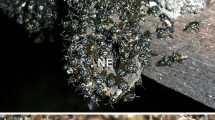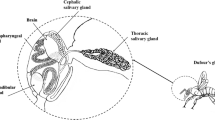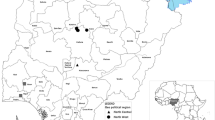Abstract
FemaleExoneura richardsoni, E. bicolor, andE. bicincta (Hymenoptera: Anthophoridae) release a pungent, staining liquid from their mandibular glands upon disturbance. This secretion is primarily composed of ethyl dodecanoate, with lesser amounts of homologous ethyl and methyl esters, salicylaldehyde, and 1,4-benzoquinone. The secretion elicits vigorous grooming when topically applied to antennae ofFormica ants. The shared, unique combination of mandibular gland lipids of these threeExoneura species supports their monophyletic classification, while the presence of salicylaldehyde may associateExoneura (Allodapini) withPithitis (Ceratinini).
Similar content being viewed by others
References
Amerine, M.A., andRoessler, E.B. 1976. Wines: Their Sensory Evaluation. W.H. Freeman and Co., San Francisco. 230 pp.
Cane, J.H. 1982. Evolution of the lipid exocrine secretions of bees. PhD thesis, University of Kansas, iv + 141 pp + Appendices 1–4.
Eisner, T., andMeinwald, J. 1966. Defensive secretions of arthropods.Science 153:1341–1350.
Heath, H.B., andPharm, B. 1978. Flavor Technology: Profiles, Products and Applications. Avi Publ. Co., Westport, Connecticut. 542 pp.
Hefetz, A., Batra, S.W.T., andBlum, M.S. 1979. Chemistry of the mandibular gland secretion of the Indian beePithitis smaragdula.J. Chem. Ecol. 5:753–758.
Michener, C.D. 1965. The life cycle and social organization of bees of the genusExoneura and their parasite,Inquilina.Univ. Kans. Sci. Bull. 46:317–358.
Vinson, S.B., Williams, H.J., Frankie, G.W., Blum, M.S., andCoville, R.E. 1982. Mandibular glands of maleCentris adani (Hymenoptera: Anthophoridae): Their morphology, chemical constituents, and function in scent marking and territorial behavior.J. Chem. Ecol. 8:319–328.
Wheeler, J.W., Blum, M.S., Daly, H.V., Kislow, C.J., andBrand, J.M. 1977. Chemistry of mandibular gland secretions of small carpenter bees (Ceratina spp.).Ann. Entomol. Soc. Am. 70:635–636.
Author information
Authors and Affiliations
Additional information
Contribution number 1842 from the Department of Entomology, University of Kansas, Lawrence, Kansas 66045.
Rights and permissions
About this article
Cite this article
Cane, J.H., Michener, C.D. Chemistry and function of mandibular gland products of bees of the genusExoneura (Hymenoptera, Anthophoridae). J Chem Ecol 9, 1525–1531 (1983). https://doi.org/10.1007/BF00988418
Received:
Revised:
Issue Date:
DOI: https://doi.org/10.1007/BF00988418




